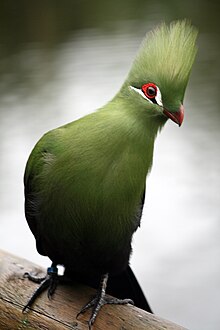| Turacos and relatives | |
|---|---|

| |
| Guinea turaco (Tauraco persa) at Birds of Eden aviary, South Africa | |
| Scientific classification | |
| Domain: | Eukaryota |
| Kingdom: | Animalia |
| Phylum: | Chordata |
| Class: | Aves |
| Clade: | Otidimorphae |
| Order: | Musophagiformes Seebohm, 1890 |
| Family: | Musophagidae Lesson, 1828 |
| Genera | |
| Synonyms | |
| |
The turacos make up the bird family Musophagidae (/ˌmjuːzoʊˈfædʒɪdiː/ "banana-eaters"), which includes plantain-eaters and go-away-birds. In southern Africa both turacos and go-away-birds are commonly known as loeries. They are semi-zygodactylous: the fourth (outer) toe can be switched back and forth. The second and third toes, which always point forward, are conjoined in some species. Musophagids often have prominent crests and long tails; the turacos are noted for peculiar and unique pigments giving them their bright green and red feathers.
Traditionally, this group has been allied with the cuckoos in the order Cuculiformes, but the Sibley-Ahlquist taxonomy raises this group to a full order Musophagiformes. They have been proposed to link the hoatzin to the other living birds,[1] but this was later disputed.[2] Recent genetic analyses have strongly supported the order ranking of Musophagiformes.[3][4][5]
Musophagidae is one of very few bird families endemic to Africa,[6] one other being the mousebirds, Colliidae. All species are frugivorous, but they also eat leaves, buds, and flowers. Figs are an important part of their diet. They have rounded wings and long tails and strong legs, making them poor fliers, but good runners.[6]
Turacos are medium-sized arboreal birds endemic to sub-Saharan Africa, where they live in forests, woodland and savanna. Turacos can occasionally be found outside of their native range as escapes from captivity.[7]
They are gregarious, non-migratory birds which move in family groups of up to 10. Many species are noisy, with the go-away-birds being especially noted for their piercing alarm calls, which alert other fauna to the presence of predators; their common name is onomatopoeia of this. Musophagids build large stick nests in trees, and lay 2 or 3 eggs. The young are born with thick down and open, or nearly-open, eyes.[8]
- ^ Hughes & Baker (1999)
- ^ Sorenson et al. (2003)
- ^ Ericson, P.G.P.; et al. (2006). "Diversification of Neoaves: integration of molecular sequence data and fossils" (PDF). Biology Letters. 2 (4): 543–547. doi:10.1098/rsbl.2006.0523. PMC 1834003. PMID 17148284. Archived from the original (PDF) on 2008-03-07.
- ^ Hackett, S.J.; et al. (2008). "A Phylogenomic Study of Birds Reveals Their Evolutionary History". Science. 320 (5884): 1763–1768. Bibcode:2008Sci...320.1763H. doi:10.1126/science.1157704. PMID 18583609. S2CID 6472805.
- ^ Jarvis, E.D.; et al. (2014). "Whole-genome analyses resolve early branches in the tree of life of modern birds". Science. 346 (6215): 1320–1331. Bibcode:2014Sci...346.1320J. doi:10.1126/science.1253451. PMC 4405904. PMID 25504713.
- ^ a b Holzman, Barbara A. (2008). Tropical forest biomes. Greenwood Press. ISBN 978-0-313-33840-3. OCLC 470649845.
- ^ "Lost and Found". www.turacos.org. Retrieved 2021-10-15.
- ^ Marchant, S. (1991). Forshaw, Joseph (ed.). Encyclopaedia of Animals: Birds. London: Merehurst Press. p. 125. ISBN 978-1-85391-186-6.